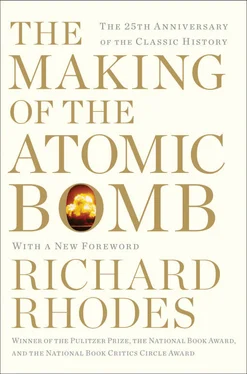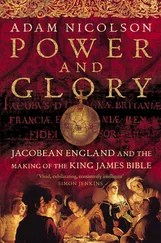Aston goes on in this lecture, delivered in 1936, to speculate about the social consequences of that energy release. Armed with the necessary knowledge, he says, “the nuclear chemists, I am convinced, will be able to synthesise elements just as ordinary chemists synthesise compounds, and it may be taken as certain that in some reactions sub-atomic energy will be liberated.” And, continuing: 519
There are those about us who say that such research should be stopped by law, alleging that man’s destructive powers are already large enough. So, no doubt, the more elderly and ape-like of our prehistoric ancestors objected to the innovation of cooked food and pointed out the grave dangers attending the use of the newly discovered agency, fire. Personally I think there is no doubt that sub-atomic energy is available all around us, and that one day man will release and control its almost infinite power. We cannot prevent him from doing so and can only hope that he will not use it exclusively in blowing up his next door neighbor.
The mass-spectrograph Francis Aston invented in 1919 could not release the binding energy of the atom. But with it he identified that binding energy and located the groups of elements which in their comparative instability might be most likely to release it if suitably addressed. He was awarded the Nobel Prize in Chemistry in 1922 for his work. After accepting the award alongside Niels Bohr—“Stockholm has been the city of our dreams ever since,” his sister, who regularly traveled with him, reminisces—he returned to the Cavendish to build larger and more accurate mass-spectrographs, operating them habitually at night because he “particularly detested,” his sister says, “various human noises,” including even conversations muffled through the walls of his rooms. 520“He was very fond of animals, especially cats and kittens, and would go to any amount of trouble to make their acquaintance, but he didn’t like dogs of the barking kind.” 521Although Aston respected Ernest Rutherford enormously, the Cavendish director’s great boom must ever have been a trial.
* * *
The United States led the way in particle acceleration. The American mechanical tradition that advanced the factory and diversified the armory now extended into the laboratory as well. A congressman in 1914 had questioned a witness at an appropriations hearing, “What is a physicist? I was asked on the floor of the House what in the name of common sense a physicist is, and I could not answer.” 522But the war made evident what a physicist was, made evident the value of science to the development of technology, including especially military technology, and government support and the support of private foundations were immediately forthcoming. Twice as many Americans became physicists in the dozen years between 1920 and 1932 as had in the previous sixty. They were better trained than their older counterparts, at least fifty of them in Europe on National Research Council or International Education Board or the new Guggenheim fellowships. By 1932 the United States counted about 2,500 physicists, three times as many as in 1919. The Physical Review, the journal that has been to American physicists what the Zeitschrift für Physik is to German, was considered a backwater publication, if not a joke, in Europe before the 1920s. It thickened to more than twice its previous size in that decade, increased in 1929 to biweekly publication, and began to find readers in Cambridge, Copenhagen, Göttingen and Berlin eager to scan it the moment it arrived.
Psychometricians have closely questioned American scientists of this first modern generation, curious to know what kind of men they were—there were few women among them—and from what backgrounds they emerged. 523Small liberal arts colleges in the Middle West and on the Pacific coast, one study found, were most productive of scientists then (by contrast, New England in the same period excelled at the manufacture of lawyers). Half the experimental physicists studied and fully 84 percent of the theoreticians were the sons of professional men, typically engineers, physicians and teachers, although a minority of experimentalists were farmers’ sons. None of the fathers of the sixty-four scientists, including twenty-two physicists, in the largest of these studies was an unskilled laborer, and few of the fathers of physicists were businessmen. The physicists were almost all either first-born sons or eldest sons. Theoretical physicists averaged the highest verbal IQ’s among all scientists studied, clustering around 170, almost 20 percent higher than the experimentalists. 524Theoreticians also averaged the highest spatial IQ’s, experimentalists ranking second.
The sixty-four-man study which included twenty-two physicists among its “most eminent scientists in the U.S.” produced this composite portrait of the American scientist in his prime:
He is likely to have been a sickly child or to have lost a parent at an early age. He has a very high I.Q. and in boyhood began to do a great deal of reading. He tended to feel lonely and “different” and to be shy and aloof from his classmates. He had only a moderate interest in girls and did not begin dating them until college. He married late… has two children and finds security in family life; his marriage is more stable than the average. Not until his junior or senior year in college did he decide on his vocation as a scientist. What decided him (almost invariably) was a college project in which he had occasion to do some independent research—to find out things for himself. Once he discovered the pleasures of this kind of work, he never turned back. He is completely satisfied with his chosen vocation…. He works hard and devotedly in his laboratory, often seven days a week. He says his work is his life, and he has few recreations…. The movies bore him. He avoids social affairs and political activity, and religion plays no part in his life or thinking. Better than any other interest or activity, scientific research seems to meet the inner need of his nature. 525
Clearly this is close to Robert Oppenheimer. The group studied, like the American physics community then, was predominantly Protestant in origin with a disproportionate minority of Jews and no Catholics.
A psychological examination of scientists at Berkeley, using Rorschach and Thematic Apperception Tests as well as interviews, included six physicists and twelve chemists in a total group of forty. 526It found that scientists think about problems in much the same way artists do. Scientists and artists proved less similar in personality than in cognition, but both groups were similarly different from businessmen. Dramatically and significantly, almost half the scientists in this study reported themselves to have been fatherless as children, “their fathers dying early, or working away from home, or remaining so aloof and nonsupportive that their sons scarcely knew them.” 527Those scientists who grew up with living fathers described them as “rigid, stern, aloof, and emotionally reserved.” 528(A group of artists previously studied was similarly fatherless; a group of businessmen was not.)
Often fatherless and “shy, lonely,” writes the psychometrician Lewis M. Terman, “slow in social development, indifferent to close personal relationships, group activities or politics,” these highly intelligent young men found their way into science through a more personal discovery than the regularly reported pleasure of independent research. 529Guiding that research was usually a fatherly science teacher. 530Of the qualities that distinguished this mentor in the minds of his students, not teaching ability but “masterfulness, warmth and professional dignity” ranked first. 531One study of two hundred of these mentors concludes: “It would appear that the success of such teachers rests mainly upon their capacity to assume a father role to their students.” 532The fatherless young man finds a masterful surrogate father of warmth and dignity, identifies with him and proceeds to emulate him. In a later stage of this process the independent scientist works toward becoming a mentor of historic stature himself.
Читать дальше












